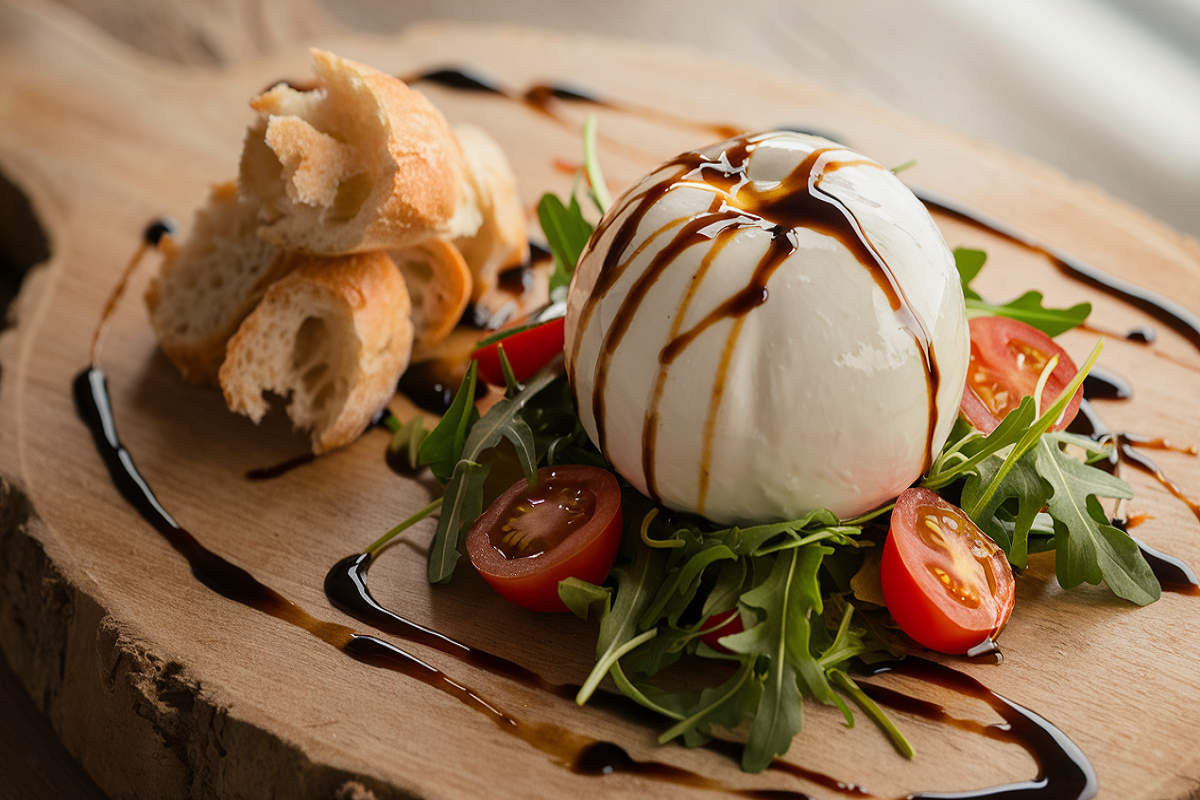Burrata, a beloved Italian cheese, combines the best of both worlds—a solid outer shell made of mozzarella and a soft, creamy interior filled with stracciatella and cream. Whether you’re new to burrata or an experienced foodie, you might wonder how burrata should be eaten to fully enjoy its luxurious texture and flavor. Fortunately, burrata’s versatility allows it to shine in a variety of dishes, from fresh salads to indulgent appetizers. Learning the best ways to serve and savor this cheese will undoubtedly elevate your culinary experience.
Introduction
Burrata stands out as one of the most luxurious cheeses in the world. With its tender outer shell and rich, velvety interior, burrata offers a truly indulgent eating experience. When considering how burrata should be eaten, several methods are available, depending on your preferences. Some prefer enjoying it as a simple starter, while others incorporate it into salads, pastas, or even as a topping for pizza. In this guide, we’ll explore the ideal ways to eat burrata, the best pairings to complement it, and tips for maximizing its creamy texture and flavor.
How to Serve and Eat Burrata Cheese
Eating burrata is an art that focuses on pairing the cheese with complementary flavors. Burrata’s delicate composition requires that it be served fresh, and its natural creaminess pairs well with simple, high-quality ingredients.
Serve at Room Temperature
One of the most important steps in enjoying burrata correctly involves allowing it to reach room temperature before serving. If you let it warm up for about 30 minutes, the flavors fully develop, and the creamy center softens, becoming even more indulgent. In contrast, burrata served too cold tends to taste blander and feels firmer, losing some of its appeal.
Pair with Fresh Ingredients
Because burrata features a rich and creamy texture, pairing it with fresh ingredients enhances its flavor without overpowering it. Some of the best pairings for burrata include tomatoes, basil, arugula, figs, peaches, and olive oil. These fresh ingredients provide a light and refreshing contrast to the richness of the cheese, allowing each bite to be more balanced and enjoyable. Additionally, a sprinkle of sea salt or cracked pepper can enhance burrata’s natural creaminess, adding just the right amount of seasoning.
Drizzle with Olive Oil or Balsamic
Drizzling high-quality olive oil or balsamic glaze over burrata significantly enhances its flavor without overpowering its delicate profile. Olive oil adds richness and depth, while balsamic glaze introduces a touch of acidity and sweetness, which contrasts beautifully with the creamy cheese. When used sparingly, both of these additions complement burrata’s natural flavors and create a harmonious balance.
Use as a Topping
Another popular way to enjoy burrata involves using it as a topping. You can place burrata atop salads, pizzas, or grilled vegetables, allowing its creamy center to spill over the other ingredients. Once you cut into it, the rich, indulgent filling spreads, creating a luxurious texture that elevates any dish. Therefore, using burrata as a topping provides an easy way to add richness to your meals without needing complex recipes.
Eat with Crusty Bread
One of the simplest and most satisfying ways to savor burrata is by spreading it over crusty bread. The contrast between the soft, creamy center and the crunch of fresh bread results in a delightful texture combination. Not only does it make for a perfect appetizer, but it also serves as a quick and easy snack that highlights the cheese’s creamy richness.
Tips for the Best Burrata Experience
When it comes to enjoying burrata, a few key tips can help maximize its unique properties. Below are some effective ways to enhance your burrata experience, ensuring you fully appreciate this decadent cheese.
Handle Burrata Carefully
Since burrata has a delicate structure, handle it gently to avoid breaking the outer shell. For best results, use a sharp knife to slice into the burrata just before serving, ensuring the creamy interior remains intact. Additionally, taking care to keep the cheese whole until you’re ready to eat it will preserve its soft center, making for a visually appealing presentation.
Serve Burrata Fresh
For the optimal burrata experience, you should aim to eat it fresh, ideally within 24 to 48 hours of purchasing it. The fresher the burrata, the better the taste and texture. Letting it sit for too long will result in a loss of flavor and creaminess, so planning to consume burrata shortly after buying ensures you enjoy it at its peak. Therefore, always prioritize freshness when serving burrata.
Use Simple Pairings
Burrata’s delicate flavor profile stands out best when paired with fresh, simple ingredients. For instance, pairing it with heavy sauces or overpowering flavors can overshadow the cheese’s subtlety. Instead, use light, seasonal ingredients such as olive oil, fresh herbs, or fruit, allowing the burrata to be the focal point of the dish. This approach ensures that the cheese remains the star without being masked by bolder flavors.
Pairing Suggestions for Burrata Cheese
Burrata’s versatility makes it an ideal partner for a wide variety of foods, ranging from savory to sweet. Below are some of the best pairing options that will enhance both the flavors and textures of this luxurious cheese.
Crusty Bread: A simple yet effective way to enjoy burrata is by serving it with fresh, crusty bread, which provides a satisfying texture contrast and allows the burrata’s creamy center to shine.
Tomatoes and Basil
The classic combination of tomatoes and basil beautifully complements the rich creaminess of burrata, bringing out the best in all three ingredients. The acidity from the tomatoes balances the cheese’s richness, while the basil adds a fresh, herbal note. For a perfect caprese salad, drizzle with olive oil and sprinkle with sea salt.
Seasonal Fruits
Pairing burrata with fresh, seasonal fruits like peaches, figs, or berries introduces a refreshing and sweet contrast to the cheese’s richness. Additionally, you can drizzle the fruit and burrata with honey or balsamic glaze for an added touch of sweetness and acidity, which enhances the overall flavor.
Grilled Vegetables
Grilled vegetables such as zucchini, eggplant, and bell peppers provide a smoky flavor that pairs beautifully with burrata’s creamy texture. Serving burrata alongside these vegetables creates a savory and indulgent appetizer or side dish, adding depth and balance to the meal.
Prosciutto and Arugula
For a savory twist, combine burrata with thin slices of prosciutto and fresh arugula. The saltiness of the prosciutto perfectly complements the creamy burrata, while the peppery bite of the arugula balances the dish, offering a delightful mix of flavors and textures.
Burrata with Crusty Bread
Pair burrata with slices of crusty bread for a simple yet satisfying meal. The contrast between the crunchy texture of the bread and the soft, creamy cheese creates a perfect bite. Additionally, adding olive oil, herbs, or roasted garlic can elevate the flavor even more, providing a complete and flavorful experience.
How Should Burrata Be Eaten in Different Dishes?

While burrata shines on its own, it also enhances a variety of dishes. Here are several ways you can incorporate burrata into meals, allowing it to serve as a star ingredient or a flavorful garnish.
As an Appetizer
Burrata makes an excellent appetizer when served on a platter with olive oil, sea salt, and fresh herbs. Adding accompaniments such as prosciutto, roasted vegetables, or crusty bread transforms this simple presentation into a substantial and elegant starter.
In Salads
Adding burrata to salads instantly elevates them with its rich texture and flavor. For instance, place burrata on a bed of arugula, spinach, or mixed greens, and top with fresh vegetables, fruits, and nuts. To bring everything together, drizzle with a light vinaigrette or balsamic glaze, which complements the creamy burrata without overpowering it.
On Pizza
For a more indulgent pizza, add burrata as a topping. After baking the pizza and removing it from the oven, place burrata on top while the pizza is still hot. The heat will gently soften the cheese, allowing the creamy center to melt slightly while still retaining its texture. This technique results in a luxurious pizza experience that combines richness with traditional flavors.
In Pasta Dishes
Burrata adds a delightful richness to pasta dishes. Instead of mixing it into the sauce, place the burrata on top of the pasta just before serving. The heat from the pasta will gradually melt the burrata into the dish, creating a creamy sauce that enhances the meal’s indulgence without overwhelming it.
In Sandwiches or Panini
Burrata elevates sandwiches or panini, bringing richness and creaminess to the fillings. Pair it with roasted vegetables, grilled chicken, or fresh tomatoes for a gourmet sandwich experience that feels both luxurious and satisfying.
Frequently Asked Questions (FAQs)
1. Should Burrata Be Eaten Warm or Cold?
Burrata should be eaten at room temperature to allow its flavors and textures to fully shine. Serving it too cold firms up the cheese and dulls its flavor, so letting it warm slightly before serving ensures the best taste.
2. How Long Can You Keep Burrata Before Eating?
Burrata is best consumed fresh, ideally within 24 to 48 hours of purchase. If you store it properly in its liquid in the refrigerator, it can last for a few days. However, for the best experience, it’s recommended to enjoy it soon after buying.
3. Can You Cook Burrata?
Burrata isn’t typically cooked due to its delicate texture. However, it can be added to dishes after cooking, such as placing it on top of a pizza or pasta just before serving. This method allows the burrata to gently melt without compromising its creamy center.
4. Can Burrata Be Substituted for Mozzarella?
Burrata can replace mozzarella in some dishes, especially if you desire a creamier texture. However, due to its creamy center, burrata works better in fresh preparations rather than dishes requiring prolonged cooking or melting.
5. What Is the Best Way to Store Burrata?
To store burrata, keep it in its original liquid in an airtight container in the refrigerator. Consuming burrata within 24 to 48 hours of purchase ensures the best flavor and texture, so it’s recommended not to keep it for long.
Conclusion
Burrata is a versatile and luxurious cheese that consistently offers a delightful contrast of textures and flavors. Whether eaten on its own or paired with simple, fresh ingredients, burrata adds an indulgent touch to any meal. Understanding how burrata should be eaten allows you to fully appreciate its unique qualities and elevate your culinary experience. By serving it fresh and pairing it with complementary flavors, you can enjoy burrata at its best, making it a star addition to your dishes.

